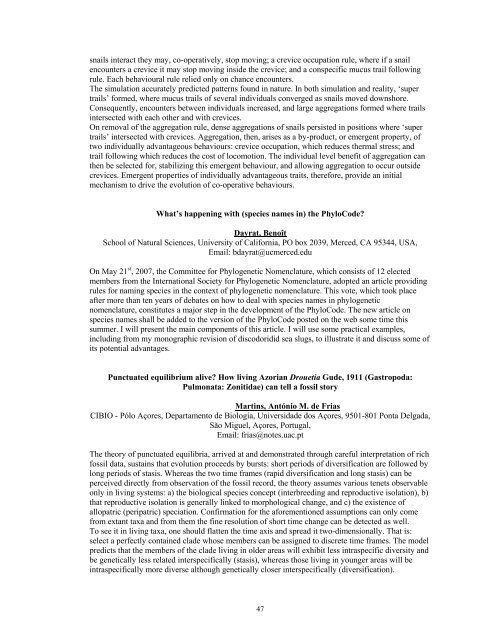World Congress of Malacology Antwerp ... - Unitas Malacologica
World Congress of Malacology Antwerp ... - Unitas Malacologica
World Congress of Malacology Antwerp ... - Unitas Malacologica
Create successful ePaper yourself
Turn your PDF publications into a flip-book with our unique Google optimized e-Paper software.
snails interact they may, co-operatively, stop moving; a crevice occupation rule, where if a snail<br />
encounters a crevice it may stop moving inside the crevice; and a conspecific mucus trail following<br />
rule. Each behavioural rule relied only on chance encounters.<br />
The simulation accurately predicted patterns found in nature. In both simulation and reality, ‘super<br />
trails’ formed, where mucus trails <strong>of</strong> several individuals converged as snails moved downshore.<br />
Consequently, encounters between individuals increased, and large aggregations formed where trails<br />
intersected with each other and with crevices.<br />
On removal <strong>of</strong> the aggregation rule, dense aggregations <strong>of</strong> snails persisted in positions where ‘super<br />
trails’ intersected with crevices. Aggregation, then, arises as a by-product, or emergent property, <strong>of</strong><br />
two individually advantageous behaviours: crevice occupation, which reduces thermal stress; and<br />
trail following which reduces the cost <strong>of</strong> locomotion. The individual level benefit <strong>of</strong> aggregation can<br />
then be selected for, stabilizing this emergent behaviour, and allowing aggregation to occur outside<br />
crevices. Emergent properties <strong>of</strong> individually advantageous traits, therefore, provide an initial<br />
mechanism to drive the evolution <strong>of</strong> co-operative behaviours.<br />
What’s happening with (species names in) the PhyloCode?<br />
Dayrat, Benoît<br />
School <strong>of</strong> Natural Sciences, University <strong>of</strong> California, PO box 2039, Merced, CA 95344, USA,<br />
Email: bdayrat@ucmerced.edu<br />
On May 21 st , 2007, the Committee for Phylogenetic Nomenclature, which consists <strong>of</strong> 12 elected<br />
members from the International Society for Phylogenetic Nomenclature, adopted an article providing<br />
rules for naming species in the context <strong>of</strong> phylogenetic nomenclature. This vote, which took place<br />
after more than ten years <strong>of</strong> debates on how to deal with species names in phylogenetic<br />
nomenclature, constitutes a major step in the development <strong>of</strong> the PhyloCode. The new article on<br />
species names shall be added to the version <strong>of</strong> the PhyloCode posted on the web some time this<br />
summer. I will present the main components <strong>of</strong> this article. I will use some practical examples,<br />
including from my monographic revision <strong>of</strong> discodoridid sea slugs, to illustrate it and discuss some <strong>of</strong><br />
its potential advantages.<br />
Punctuated equilibrium alive? How living Azorian Drouetia Gude, 1911 (Gastropoda:<br />
Pulmonata: Zonitidae) can tell a fossil story<br />
Martins, António M. de Frias<br />
CIBIO - Pólo Açores, Departamento de Biologia, Universidade dos Açores, 9501-801 Ponta Delgada,<br />
São Miguel, Açores, Portugal,<br />
Email: frias@notes.uac.pt<br />
The theory <strong>of</strong> punctuated equilibria, arrived at and demonstrated through careful interpretation <strong>of</strong> rich<br />
fossil data, sustains that evolution proceeds by bursts: short periods <strong>of</strong> diversification are followed by<br />
long periods <strong>of</strong> stasis. Whereas the two time frames (rapid diversification and long stasis) can be<br />
perceived directly from observation <strong>of</strong> the fossil record, the theory assumes various tenets observable<br />
only in living systems: a) the biological species concept (interbreeding and reproductive isolation), b)<br />
that reproductive isolation is generally linked to morphological change, and c) the existence <strong>of</strong><br />
allopatric (peripatric) speciation. Confirmation for the aforementioned assumptions can only come<br />
from extant taxa and from them the fine resolution <strong>of</strong> short time change can be detected as well.<br />
To see it in living taxa, one should flatten the time axis and spread it two-dimensionally. That is:<br />
select a perfectly contained clade whose members can be assigned to discrete time frames. The model<br />
predicts that the members <strong>of</strong> the clade living in older areas will exhibit less intraspecific diversity and<br />
be genetically less related interspecifically (stasis), whereas those living in younger areas will be<br />
intraspecifically more diverse although genetically closer interspecifically (diversification).<br />
47



